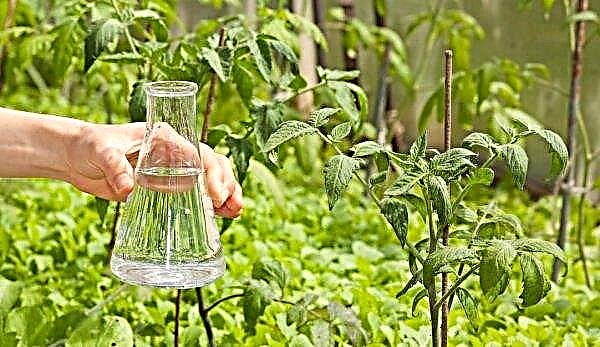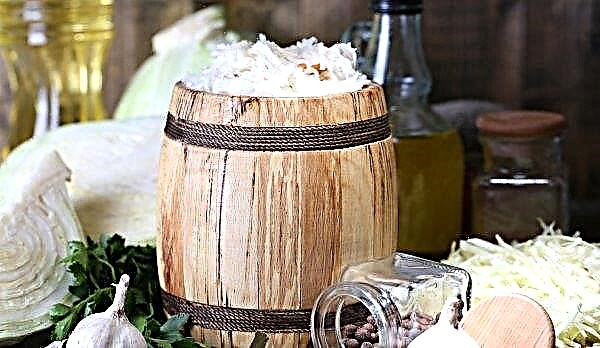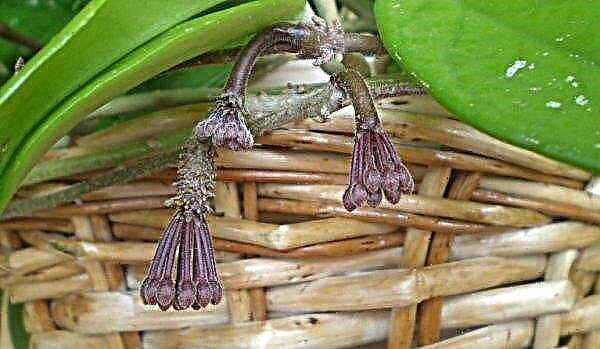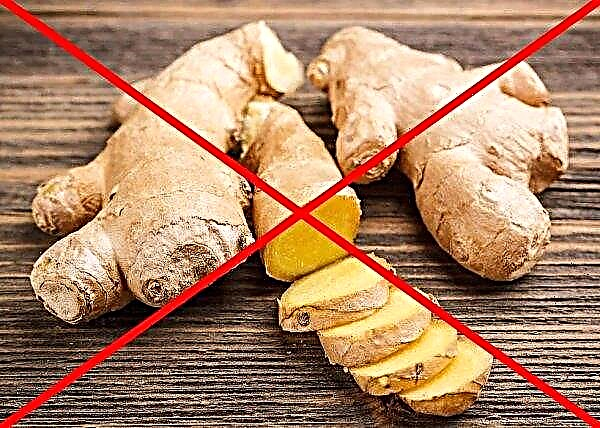Zamiokulkas (“dollar tree”, or “celibacy flower”) is known among flower growers for its unpretentiousness, as well as for its memorable and exotic appearance. However, often this beneficial combination is spoiled by pests and dangerous infections that reduce the decorative value of the flower. The article considers what is the main reason for the appearance of pathologies in a plant, and also describes ways to combat them.
What diseases affect the plant?
Dangerous fungal pathologies are the first problem that the florist encounters, and it is often difficult to eliminate them. In the case of zamioculcas, this is no less relevant, therefore, if you find signs of a fungal disease on the flower, you should immediately begin to eliminate it, otherwise an additional infection will join the underlying disease.
Anthracnose
Fungal infection caused by microscopic ascomycetes. The disease is found everywhere, so it affects both ornamental and fruit crops of plants. The infection is high, fungal spores are actively spreading. Infection is considered one of the most dangerous, since during its development, damage to the entire aerial part of the plant is observed, which leads to the death of the latter.
Among the causes of the defeat of the "dollar tree" by anthracnosis, the most common are:
- reduced flower immunity due to other infections and diseases;
- mechanical damage to the leaves and stem;
- increased acidity of the substrate;
- combination of high temperature (+22 ... + 27 ° С) and humidity (about 90%);
- deficiency of potassium and phosphorus in the soil;
- the use of contaminated substrate, pots and equipment for care.
It is not difficult to identify the first signs of anthracnose - the leaves of the affected specimens are covered with dark spots of a brown shade, with a darker, brownish-brown border. Gradually, they also appear on the stem, which reduces the flow of nutrients to the cells. The hue of the border changes to violet-brown. In the summer heat, the affected leaves may crack, causing large putrid foci.Did you know? Zamioculcas is known as the “celibacy flower” because of its resemblance to spathiphyllum, which is popularly associated with separation for decades.
To combat anthracnosis, spraying with highly active fungicidal preparations is used.
The most popular are:
- Bordeaux liquid;
- 1% copper sulfate;
- colloidal sulfur.
Spraying is performed twice, with an interval of 1-2 weeks. If necessary, the procedure is carried out additionally, but not more than 1 time in 14 days.
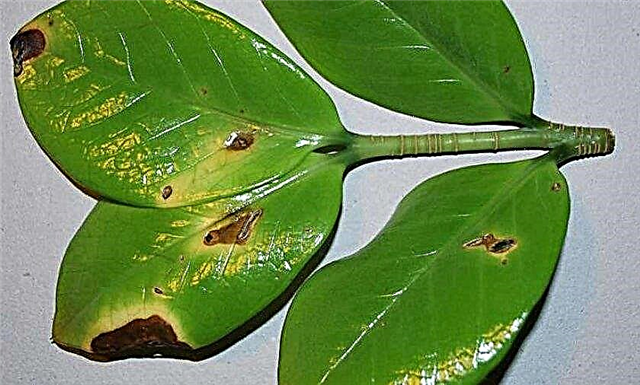
Powdery mildew
Called by a microscopic parasitic fungus from the order of erisif. Infection provokes a slow wilting of plants, which reduces their decorativeness. Damaged parts of the flower cease to grow, so they die. The most common infection is due to infected inventory.
A microorganism exists everywhere in nature, however, its occurrence in a flowerpot with a flower is caused due to a combination of the following conditions:
- reduced flower immunity;
- high humidity;
- sharp temperature difference;
- increased concentration of nitrogen in the substrate;
- pruning with a previously infected tool.
To determine the defeat of powdery mildew is simple - you need to carefully examine zamioculcas. The main sign of infection is a characteristic white coating that appears on the foliage and stem. Over time, it thickens and changes color to a deep brown color, small brown balls appear on its surface - spores of the microorganism.
To cope with the infection, the infected dollar tree is sprayed twice (with an interval of 14 days) with Topaz or Skor. It is also possible to overcome the disease with the help of folk methods.
To do this, use a 1% solution of potassium permanganate or natural infusions, the most effective of which are:
- Milk liquid - 3 liters of serum and 1 tsp are dissolved in 7 l of water. copper sulfate. Apply 1 time per week until the infection disappears completely.
- Onion broth - 100 g of onion husks pour 5 l of water, the mixture is insisted for 2 days, after which they are used to irrigate the affected parts of the flower. Use 1 time per week, until the destruction of the fungus.

Sooty (black) fungi
Sooty fungi are called strains of parasitic microorganisms from the genus Aspergillus. The main source of the disease is soil with plant debris. However, the infection enters the flowerpot with zamioculcas by means of insects, including parasites. They carry fungal spores and secrete viscous substances that allow them to grow on the surface of the flower.
The appearance of sooty fungi also provoke:

- thickening of the windowsill;
- high humidity combined with heat;
- poor room ventilation;
- low immunity of the flower.
It is not easy to identify sooty fungi, the defeat of the plant by the microorganism is blurred, the symptoms of which are similar to many diseases. However, small black or dark gray spots are considered a clear sign of infection. Over time, they combine, creating large foci. If no remedial measures were taken during this period, the flower will be completely covered with a black film, the leaves will fall off and the stem will dry.
To cope with the infection, the resulting plaque is removed with moist cotton soaked in a saturated soda solution. The most affected leaves are removed, since it is impossible to cure them. After the flower is sprayed with any copper-based fungicide. The most commonly used drugs are Ditan, Strobi, Horus or Skor. The procedure is carried out 2 times with an interval of 2 weeks, but if necessary, it is extended.
You can replace drugs with folk remedies - it is popular to use a mixture of 1 liter of water, 5 g of copper sulfate and 150 g of crushed soap. The flower is treated with this mixture once a week, until the traces of infection disappear completely.
Rot
Rot is one of the most common infectious diseases. Pathology is manifested by foci of decay on the stem, leaves and roots. It appears suddenly and after a few weeks can lead to the complete destruction of the "dollar tree". Microscopic fungi cause the disease, which fall into a pot of contaminated water, from the soil, through inventory or air.
Causes of rot:
- excessively moist air and soil;
- low plant immunity;
- irregular top dressing.
 Rot appear wet spots of gray, brown or black. They can be perfectly rounded and blotted. Almost all parts of the flower are rotten. As the disease develops, the spots fuse together, forming large foci. This leads to inhibition of zamioculcas and slow withering.
Rot appear wet spots of gray, brown or black. They can be perfectly rounded and blotted. Almost all parts of the flower are rotten. As the disease develops, the spots fuse together, forming large foci. This leads to inhibition of zamioculcas and slow withering.They fight rot by adjusting the humidity of the substrate and air. At the same time, powerful fungicidal agents are used, among which the drugs: “Topsin”, “Ronilan” and “Sumileks” can be called particularly effective. The fungicides are treated 2 times, with a frequency of 14 days.
Important! Parasitic infections of plants are not dangerous for humans and domestic animals, therefore, their treatment does not require moving to quarantine. A measure is necessary when other plants are grown on the windowsill to prevent their infection.
Pests that infect a plant
Insects are no less dangerous than fungi. Their parasitism reduces the decorative value of plants, and also negatively affects immunity. In this regard, additional damage by bacterial, viral infections and fungi is often observed.
Mealybug
Powdery mealybug is a collective name for small sucking insects from the semi-rigid winged family, ranging in size from 0.3–0.5 to 3–6 mm. They got their name due to the characteristic white viscous coating covering the body of the parasite. Almost the entire life cycle of the insect passes on the surface of plants, which serve as a food base for it. Juice from stems and foliage actively feeds both larvae and adults.
The body of the worms is elongated, oval, the upper part is covered with scaly formations of a whitish color. The species is characterized by sexual demorphism, which means that individuals are divided into female and male forms.
The number of legs of the worm is not a constant number, depending on the subspecies, they may be absent or there may be several. The insect is characterized by increased fecundity; a sexually mature female is capable of producing up to 4 generations of offspring per year. The oral apparatus of a sucking pest, there are small antennae near the oral cavity.
A pest appears instantly, often this provokes:
- increase in air temperature up to + 25 ° С and more;
- high atmospheric humidity;
- excess moisture in the soil.
To determine the damage to the "dollar tree" by insects, you can, thanks to the following symptoms:
- foci of white, powdery plaque appear on the leaves and stem;
- sticky spots appear throughout the plant - the waste products of the parasite;
- green mass acquires small brown marks - bite marks;
- the flower slowly fades, turgor of leaf mass decreases.
In order to overcome the parasite, a sick plant must be carefully treated with an antococidal insecticide. The most commonly used drugs are Actellic, Calypso and Fitoverm.
Before the procedure, the entire green mass is thoroughly cleaned with a moist cotton pad soaked in soapy water. Depending on the activity of reproduction of the parasite, zamioculcas is treated from 1 to 3 times, with an interval of 10 days. A soap-alcohol solution can be used as a less toxic alternative. Prepare it from 1 liter of water, 2 g of soap and 10 ml of denatured alcohol.
Thrips
Thrips include small insects with three pairs of legs. On each of them there are special suction cups or claws with which they cling to the plant. The body of the parasite is elongated, about 3 mm long. The color of the insect is diverse, there are species of green, brown, black and red shades. The belly of thrips is divided into several segments, on the back in adults there is a pair of wings, in larvae they are absent.
Thrips are an omnivorous species, in search of food they are able to parasitize on almost any plant. However, often the parasite has a certain specialization in relation to the food supply, therefore this or that type of thrips can be found on a narrow circle of plants. The insect is capable of parasitizing for a long time without causing external manifestations, therefore it is not possible to detect it even for several years.
Did you know? Thripses are characterized by social behavior. On each affected plant, a separate family arises in which insects are divided into groups (working insects, guards).
The main reason for the appearance of the insect can be called the creation of a favorable microclimate for its development and reproduction. Most often they occur in dry and hot summers with a temperature of at least + 25 ° C, as well as with excessively intense heating in winter. Also, the use of infected soil or equipment provokes the appearance of an insect.
With massive development, thrips provoke characteristic signs of damage:
- a sticky transparent mass appears - insect secretions;
- small spots appear on the green mass, which increase with time;
- plant growth is inhibited, as well as the growth of green mass;
- spontaneous foci of infectious lesions occur as a result of reduced immunity.
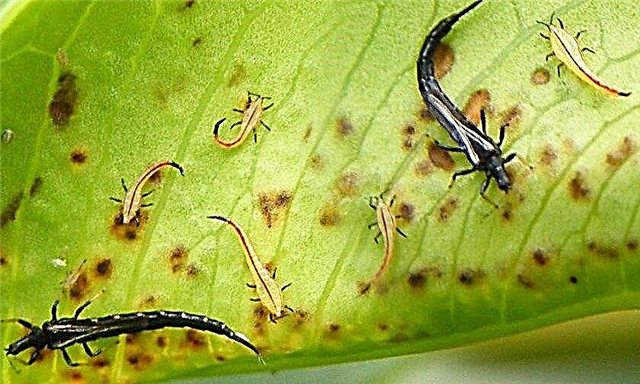
You can cope with an insect with the help of active industrial insecticides (Actellik, Vermitek, Fitoverm). After the first treatment, almost all insects die, however, the drugs are powerless against the eggs of the parasite. In this regard, the procedure is repeated at least 3-4 times, with an interval of 7-10 days.
You can also get rid of thrips with the help of folk infusions, for example, tobacco dust. To prepare it, 100 g of tobacco dust is poured into 1 liter of warm water. The mixture is insisted for a day, after which it is filtered and used to spray the green mass. The procedure is carried out once a week, until the disappearance of the parasite.
Ticks
The so-called spider mite lives on the planet everywhere, so it is considered one of the most common parasites. It is a small insect, about 0.5 mm long. Larvae are often bright pink, the color of adults varies in green, brown and dark red shades. Young individuals have 3 pairs of legs, adults - 4. The insect multiplies rapidly, the full development of the embryo takes no more than 15 days.
The main danger of the tick is that it manifests itself several months after infection. It can be detected only during mass reproduction, at this time:
It can be detected only during mass reproduction, at this time:
- a flower throws off foliage;
- shoots slowly fade, their tip dries out;
- growth of green mass is inhibited;
- the back of the leaves is covered with small bright dots;
- a light cobwebbed coating appears on the bottom of the leaves.
You can remove the insect from the flowerpot using the “Actellik” and “Aktara” preparations. Working solutions spray the plant twice, after 14 days. Before spraying, the flower must be thoroughly cleaned of the remains of the web. To do this, use a wet cotton swab or a cotton swab.
Alternative drugs can replace drugs. As an alternative, use an infusion of dandelion leaves. Prepare it from 500 g of plant leaves and 10 l of hot water. The mixture is insisted for 2-3 days, and then filtered. Also effective is a decoction of alder leaves: 2 kg of leaves are mixed with 10 liters of warm water, and then the mixture is insisted for about a day. The infusion is boiled, and then kept for another day and filtered. Use folk remedies 1 time in 7-14 days.
Shields
Scabies are among the most dangerous pests of the family Equine. They tend to parasitize almost all cultivated plants, and especially decorative species. Scaffolds are small, a mature individual does not exceed 3 mm in length. The body shape of the insect is rounded, covered with a powerful wax shield. There are many thin legs on the body with which the parasite actively moves.
Young individuals are characterized by active movement along the surface of plants. Adult females lead an attached lifestyle. A dense carapace forms on their body, protecting the body from damage. Males always lead a mobile life, a pair of wings helps them in this additionally.
There are many reasons for the appearance of the parasite on domestic plants, but scabies most often arise due to combinations of several favorable factors at once. First of all, this is a high temperature and dryness, as well as low immunity of the plant.
It is not difficult to detect the first signs of development of scale insects:
- the affected plant begins to lag behind in growth, slowly fade;
- small roundish plaques of green or brown color appear on the green mass, often located along the veins;
- leaves become sticky due to the special secret of insects.
It is difficult to get rid of shields - a powerful shell of females perfectly protects their body, as well as offspring from insecticides. The first measure for treating a flower is its removal of plaques. To do this, use a cotton swab or a cotton swab dipped in soapy water.
Important! Each new plant in the house must be treated prophylactically with insecticides and fungicides.
The purified zamioculcas should then be treated with an insecticide (Actellik, Bankol, and Mospilan).The procedure is carried out 2 times, with an interval of 2 weeks. Window glass, windowsill and all objects in contact with the flower should also be processed. They can carry on their surface larvae or eggs of insects.
Problems with Zamioculcus leaves
Sometimes the main reason for the decrease in the decorative value of zamioculcas is errors in its content, which leads to external manifestations (yellowness, dryness). Such conditions are no less dangerous, since they often provoke dire consequences.

Turn yellow
The most striking manifestation of the physiological changes of the plant is considered to be yellowness of green mass. It occurs for a number of unfavorable reasons leading to the decomposition of chlorophylls and further wilting of the leaves. Often this indicates non-compliance with the irrigation regime. In this case, pale yellow leaves and dark spots on the petioles appear, which indicates an overflow. It provokes damage to the root system with purulent foci.
Also, the foliage may turn yellow due to an unbalanced temperature regime, in which case the spots acquire a characteristic "ragged" outline. Such pathologies often arise due to sunburn, but can also occur when the flower is hypothermic in winter.
Video: Zamioculcas leaves turn yellow, what to do
Wilt
In most cases, the leaves fade due to natural aging. At this time, the cells stop dividing, which leads to the gradual death of the leaf blade. However, such leaves are easy to identify, since they appear only in the lower tier of the plant. The defeat of the young leaves indicates serious problems in care caused by irregular watering.
Drying of the leaves is often provoked by insufficient watering, while inhibition of flower growth is also observed. Putrid spots, accompanied by wilting, indicate a pot overflow or root hypothermia with cold water. In this case, rotting of the root system is often observed.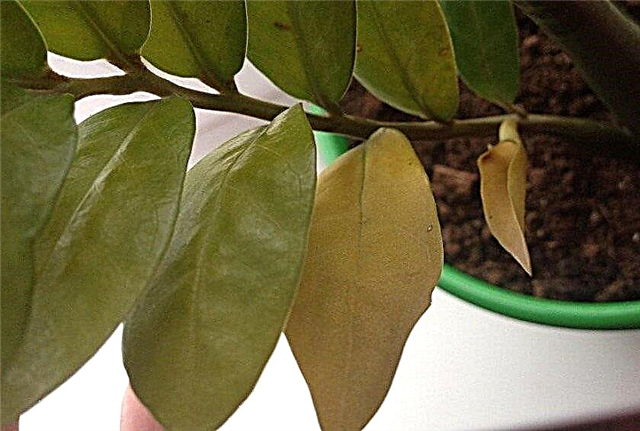
Stains
Spotting plants can be divided into several groups, depending on their color.
Spotted:
- dark brown - The first evidence of improper watering (overflow) of a flower. They appear after putrefactive lesions of the root system as a response to a violation of the absorbing ability of the roots;
- brown, blotchy - appear as a response of cells to hypothermia, in which case they slow down the metabolism and slowly die;
- large black spots on the petiole - indicates that part of the roots of the flower died due to waterlogging of the soil.
Did you know? In Chinese culture, Zamioculcas is the official symbol of the New Year. Without it, not a single celebratory event is held.
Sticky spots on the leaves
Sticky, uncharacteristic liquid on the green mass occurs due to damage to the flower by pests. This substance is a product of the life of insects and accumulates only in the case of mass development of parasites. The substance is dangerous, it contains many by-products, which become the best nutrient medium for the development of fungi. In this case, if the fungal-parasitic infestation is untimely detected, it can ruin Zamioculcas in just 15–20 days.

Root problems
Damage to the root system is the main cause of problems in all plants, therefore, such changes cannot be ignored. Even without external manifestation, they provoke many pathological processes that, without timely stopping, can lead to a sharp death of the plant.
Are dry
If the root system of the "dollar tree" begins to dry and wither - this is the main evidence of the meager moistening of the flowerpot. Pathology rarely occurs, since the onion root system of the species is able to accumulate moisture and use it during adverse conditions. It is not difficult to fix the problem, it is enough to adjust the irrigation system. The substrate needs to be watered regularly, however, the soil should dry well.
Rot
Rotting provokes saturation of the substrate with moisture. The problem often arises, since only a few flower growers painstakingly study all the requirements for caring for the plant. To save zamioculcas, it must be transplanted into a new substrate, while the affected parts of the roots must be removed. Before planting, the roots are treated with Fitosporin solution or 2% potassium permanganate.
Also, rotting provokes a substrate unsuitable for flower growth. For transplantation, nutritious chernozem, peat mixtures, etc. are often used, however, only sandy loam soil with low moisture capacity is suitable for the flower. Only in this case can an instant removal of harmful moisture be achieved.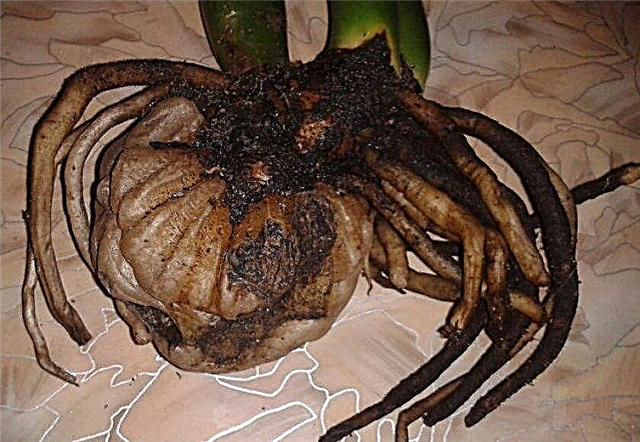
Blacken
If the blackening of the roots is not accompanied by other manifestations, and the regime of watering the flower is observed, in this case the phenomenon does not have a pathological nature. All roots are subject to such processes, which indicates their growing up. In addition, the appearance at the top of the blackened roots of light, growing tips also indicates this.
Spots on the roots
Spotting on the root mass occurs in case of non-compliance with the requirements of the plant for irrigation. In addition to the saturation of the soil with moisture, such a reaction is often observed when using cold water, which provokes supercooling of the roots and the death of their cells. To save the "dollar tree", it is enough to replace cold water with warmed up to the environment and well-defended. At the same time, to quickly improve the condition of the flower and normalize the soil microclimate, the irrigation rate is halved by 2 weeks.
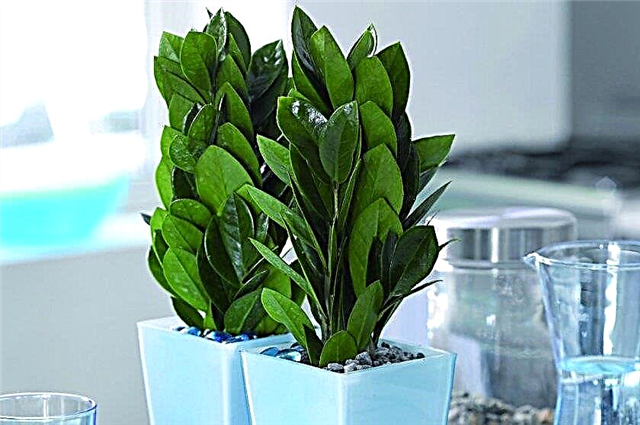
Preventative measures
Diseases and pests of indoor flowers are not uncommon, so you need to deal with them thoroughly, even before the first signs of a flower's defeat. This will get rid of unnecessary problems, as well as deterioration of the decorativeness of your favorite flower. For this, the plant must be periodically treated with insecticidal and fungicidal preparations. Such procedures are carried out every 2 months or at least 2 times a year, at the end and beginning of the active growing season.
Often dangerous infections get due to artificial skidding. To avoid it, the soil must be sterilized during transplantation; the entire inventory is also subjected to this procedure.
Important! With an increase in the home flower garden, all new plants are sent for two-week quarantine, since potentially most of them are carriers of dangerous diseases.
In addition, the following measures will help protect the dollar tree from disease:
- strict adherence to irrigation regimen;
- regular feeding, in the summer they are carried out at each watering, in winter and autumn - every other time;
- Once a month a flower must create a warm shower;
- the species grows better in tight pots; large containers often inhibit its resistance to infections;
- the plant tolerates bright lighting well, but it is better for it to provide soft and diffused light.

Common processing errors
Mistakes in processing plants are not uncommon, however, they harm no less seriously than diseases, so before you start treating a flower, you need to take into account the negative experience of other gardeners.
The main errors in the processing of plants, measures for their elimination and prevention:
| Description | Remedies |
| Non-compliance with the concentration of substances (leads to flower burns) | Before processing plants, get measuring glasses and pipettes. |
| Mixing two drugs | Before each treatment, clean all volumetric containers and auxiliary equipment. |
| Neglecting the timing between sprays | During the treatment of the flower, create a special calendar in which to add the processing time, amount and type of drug used. |
| Wrong drug choice | Each disease is treated with a narrow range of drugs, so before spraying, you need to study its instructions, as well as accurately determine the ailment. |
| The annual use of the same drugs (due to which their effectiveness decreases) | Drugs should be replaced at least 1 time per year, to create a special schedule for the use of protective equipment for monitoring. |
| Long-term storage of solutions | Store working fluids no more than 24 hours after preparation; subsequently, their effectiveness decreases. |
Diseases and pests often affect zamioculcas, since a home pot is not the best place for the functioning of the natural immunity of a flower. Zamioculcas needs regular care, examination and preventive measures.



